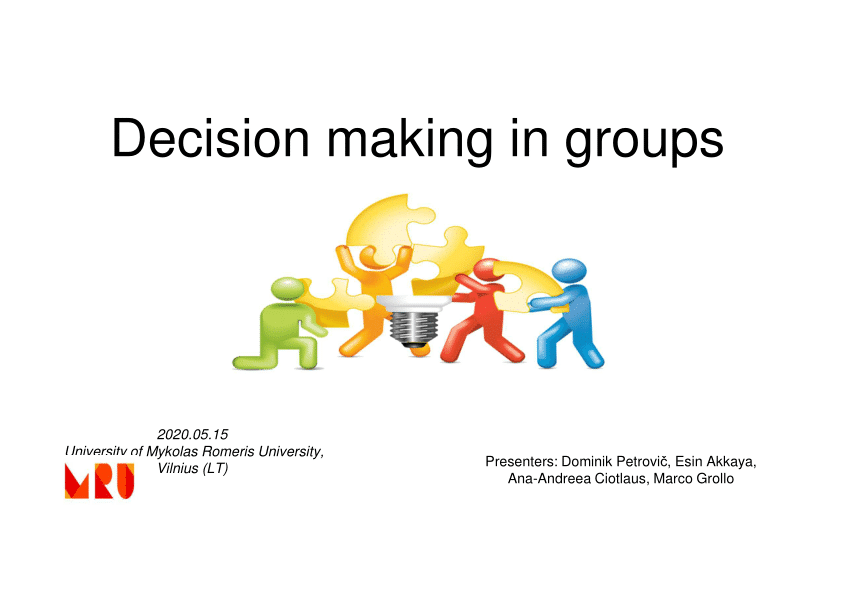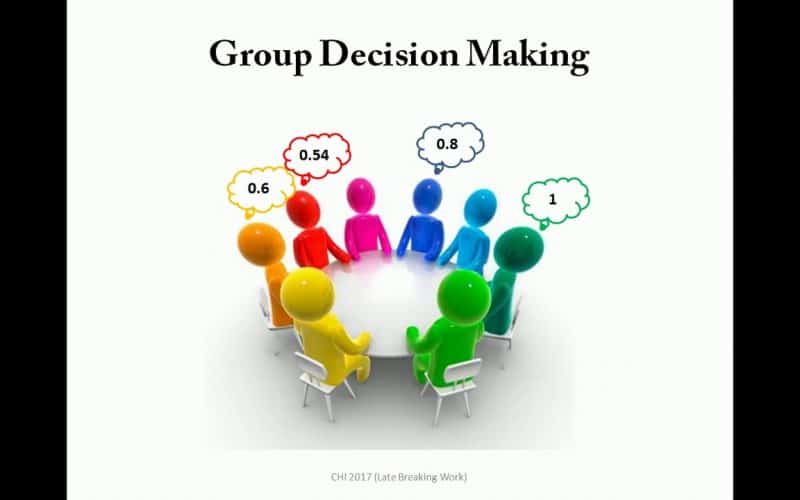In every group, team members must make decisions. However, different people can come up with diverse alternatives. The basic problem is how can this group select the best alternative without hurting the other party. There are several techniques and methods of group decision-making. However, this article will discuss in detail some of these techniques and processes with a perfect example of group decision-making.

Without further all do, let’s get down to the business of the day.
Group Decision Making
Group decisions may involve understanding a huge amount of information, exploring different ideas, and drawing on many strands of experience. Also, group decision-making is when individuals collectively make a choice from the options before them. However, such decisions are not for any single individual, but for the group as a whole.
Group decisions are participatory, and often how a particular decision would affect a member is determined by his/her contribution. However, group decisions are subject to factors such as social influence, peer pressure, and group dynamics. Also, these social elements can alter the process by which decisions are reached and the decision outcomes themselves. A group can make decisions by consensus, in which all members come to an agreement. Also, by taking a majority-rules strategy and select the option chosen by most members.
Furthermore, the number of people included in group decision-making differs greatly but often ranges from two to seven. The individuals in a group may be demographically related or quite distinct. However, decision-making groups may be somewhat informal in nature, or formally assigned and charged with a specific goal.
Additionally, the process used to arrive at decisions may be unstructured or structured. However, the nature and structure of groups, their size, demographic makeup, and purpose, all affect their functioning to some extent.
What Is the Process of Group Decision-Making?
Each member of the group chooses five ideas (or fewer) they like best and ranks them from one to five, with five being the best. Every vote is recorded and added up on the board. The most successful proposal is chosen.
What Is the Importance of Group Decision-Making?
Among the benefits of making decisions collectively are: Produces better results. Offers a broader view. uses one’s imagination.
Group Decision-Making Techniques/Methods
There are several techniques and methods of group decision-making. However, here are the selected few techniques/methods of group decision-making.
Brainstorming
Brainstorming is a popular technique that aims at creating as many ideas as possible. For this, you will need a group of members. However, the average number is from 5 to 9 people, a group leader, and a flipchart.
Also, the brainstorming process has two stages:
Stage 1
Here, the group leader explains the situation in detail so that each member has a clear vision of the problem. Hence, group members suggest their ideas while the leader writes them down on a flip chart.
Stage 2
Now, after the group suggests all the possible decisions, they decide if each decision meets their success criteria.
Sometimes group members may feel awkward presenting their ideas. To resolve this issue, you could propose brainstorming anonymously in a voting app, chat, or by email.
Nominal group thinking
Nominal group thinking relates to brainstorming. Although it is better structured and promotes independent acting rather than working in a group. Members don’t need to interact with one another. Hence, they aren’t biased towards the opinions of ruling personalities.
Delphi technique
Delphi technique works best with a group of experts that work remotely. Therefore, group members don’t need to gather in one place to find the best solution to a problem. Here, each member is usually an expert in a particular field. Hence, they have their own vision of handling an issue.
Dialectical inquiry
The dialectical inquiry is another group decision-making technique that involves teamwork and focuses on the discussion of choices. This technique helps to reveal the hidden problems that may appear within the issue. It can also help choose whether to go with a decision or not if there’re too many advantages and disadvantages to decide upon. Think of it, like a tie-breaker.
The technique can be modified into a devil’s advocacy method. It means that one group member counters the participants’ ideas, suggesting opposed ideas hence revealing the potential problems.
What Has the Biggest Impact on Group Decision-Making?
Group polarization, which occurs when members’ attitudes toward a topic become more extreme after being discussed in depth, can also affect the outcomes of group decisions. Juries’ decision-making abilities can be improved by studying group dynamics.
Now, let’s discuss the process involved in group decision making.
Group Decision-Making Process
The group decision-making has four processes to come to a conclusion. However, you must plan, determine alternatives, select the best alternative, and then deploy.
#1. Planning
Group planning is the act of setting the goals, vision and objective of a group.
Also, the planning stage occurs in two phases:
First, choose which types of decision-making techniques you will use – meetings, brainstorming sessions, etc. Secondly, you need to how you will know that the decision made is a success. To understand that, you need to formulate the success factors or rules for your decision.
#2. Determining alternatives
At the determining alternatives stage, your expert group should create and select various alternative decisions. They need to choose from 5 to 9 alternatives that best meet the planning session’s terms. This step is crucial as it lessens the number of decisions and keeps the group focused on the most effective ones. You could also search for similar alternatives in past situations and consider if they suit the current issue.
#3. Selecting the best alternative
It’s time to choose the best alternative from the solutions selected at the determining alternatives stage. To do so, you need to compare each decision to the standards set at the planning stage of your decision-making process. The solution that meets most standards is the most effective one.
#4. Deployment
At the deployment stage, you bring your decisions into play. This involves preparing the actions and tasks that follow the final decision. It also includes the guiding requirements on how to organize the process.
How Can Group Decisions Be Made More Effective?
Participation from all members of a group is crucial to the success of any decision-making process. The best decisions are made when all relevant parties are given the opportunity to consider potential solutions and provide constructive criticism and input.

Examples of Group Decision Making
A typical example of group decision making is a personal experience i had in my group.
My group is a group involved in entertainment. However, we decided to decide whether to organize an event in 2020 or wait until 2021. Hence, we had two alternatives to pick from. We had to have a meeting and discussed what we should do. The first thing we did was to plan by setting out our goal for the year. Secondly, we determined how the two alternative decisions will affect our goal. After different decision-making techniques like brainstorming, we selected the best alternative which was to wait until 2021. Now, in 2021, we did the event and it was shut down.
Advantages and Disadvantages of Group Decision Making
The following are the Advantages and Disadvantages of Group Decision Making
Advantages of Group Decision Making
You can take into account various viewpoints and ideas when you involve groups in decision-making. However, a varied group is required for this advantage to be achieved. Each member of a varied group will typically have unique preferences, opinions, biases, and stereotypes. Group decision-making requires more work from management since multiple points of view must be discussed and resolved, but it also tends to lessen the impact of bias on the result (if the group members reflect varied perspectives). For instance, a recruiting panel made of entirely of men would choose to hire more male applicants (simply because they tend to prefer people who are more similar to themselves). However, the bias need to be neutralized by a hiring committee that is equally composed of men and women, leading to more candidates being recruited for their qualifications as opposed to their physical characteristics.
Additionally, it is advantageous to involve more people in decision-making because each person contributes distinct knowledge and viewpoints to the group. Multiple participants also frequently result in more possibilities being developed and higher levels of intellectual stimulation as group members discuss the options. As many answers or options as you can come up with are generated through the process of brainstorming, which is a well-known strategy used in group decision-making.
When groups make decisions, all of these elements may result in better results. Additionally, involving those who will be impacted by a decision can help them develop a deeper awareness of the difficulties or challenges at hand as well as a stronger commitment to the solutions.
Disadvantages of Group Decisions
Making decisions in groups is not always easy. Conflict can bog down certain organizations, while other groups take it too far and drive for consensus at the expense of productive talks. Groupthink is when participants decide not to express their reservations or disagreements in order to maintain harmony and avoid upsetting or enraging other participants. When there is a strong sense of camaraderie and teamwork within the group, it can often lead to groupthink because no one wants to see that by generating conflict. It can also happen when a team becomes complacent as a result of prior triumphs.
Often, one person in the group has more authority or influence than the others and suppresses dissent to prevent people with opposing views from speaking up so that only their own ideas are put into action. However, the group will not reap the rewards of collective decision-making if members are not genuinely contributing their thoughts and perspectives.
Conclusion
In conclusion, decision making is a crucial aspect of every group. The example of group decision-making is what you can go through and also relate with.
Group Decision-Making FAQs
What is the group decision making process?
- Planning
- Determining alternatives
- Selecting the best alternative
- Deployment
What are the types of group decision making?
Here are the selected few techniques/methods of group decision-making.
- Nominal group thinking
- Delphi technique
- Dialectical inquiry
- Brainstorming






